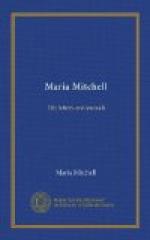“It is always so—you cannot get a man of genius to explain steps, he leaps.
“After the discovery of this planet, Professor Peirce, in our own country, declared that it was not the planet of the theory, and therefore its discovery was a happy accident. But it seemed to me that it was the planet of the theory, just as much if it varied a good deal from its prescribed place as if it varied a little. So you might have said that Uranus was not the Uranus of the theory.
“Sir John Herschel said, ’Its movements have been felt trembling along the far-reaching line of our analysis, with a certainty hardly inferior to ocular demonstration.’ I consider it was superior to ocular demonstration, as the action of the mind is above that of the senses. Adams, in his study at Cambridge, England, and Leverrier in his closet at Paris, poring over their logarithms, knew better the locus of that outside planet than all the practical astronomers of the world put together....
“Of course in Paris I went to the Imperial Observatory, to visit Leverrier. I carried letters from Professor Airy, who also sent a letter in advance by post. Leverrier called at my hotel, and left cards; then came a note, and I went to tea.
“Leverrier had succeeded Arago. Arago had been a member of the Provisional Government, and had died. Leverrier took exactly opposite ground, politically, to that of Arago; he stood high with the emperor.
“He took me all over the observatory. He had a large room for a ballroom, because in the ballroom science and politics were discussed; for where a press is not free, salons must give the tone to public opinion.
“Both Leverrier and Madame Leverrier said hard things about the English, and the English said hard things about Leverrier.
“The Astronomical Observatory of Paris was founded on the establishment of the Academy of Sciences, in the reign of Louis XIV. The building was begun in 1667 and finished in 1672; like other observatories of that time, it was quite unfit for use.
“John Dominie Cassini came to it before it was finished, saw its defects, and made alterations; but the whole building was afterwards abandoned. M. Leverrier showed me the transit instrument and the mural circle. He has, like Mr. Airy, made the transit instrument incapable of mechanical change for its corrections of error, so that it depends for accuracy upon its faults being known and corrected in the computations.
“All the early observatories of Europe seem to have been built as temples to Urania, and not as working-chambers of science. The Royal Observatory at Greenwich, the Imperial Observatory of Paris, and the beautiful structure on Calton Hill, Edinboro’, were at first wholly useless as observatories. That of Greenwich had no steadiness, while every pillar in the astronomical temple of Edinboro’, though it may tell of the enlightenment of Greece, hides the light of the stars from the Scottish observer. Well might Struve say that ’An observatory should be simply a box to hold instruments.’




